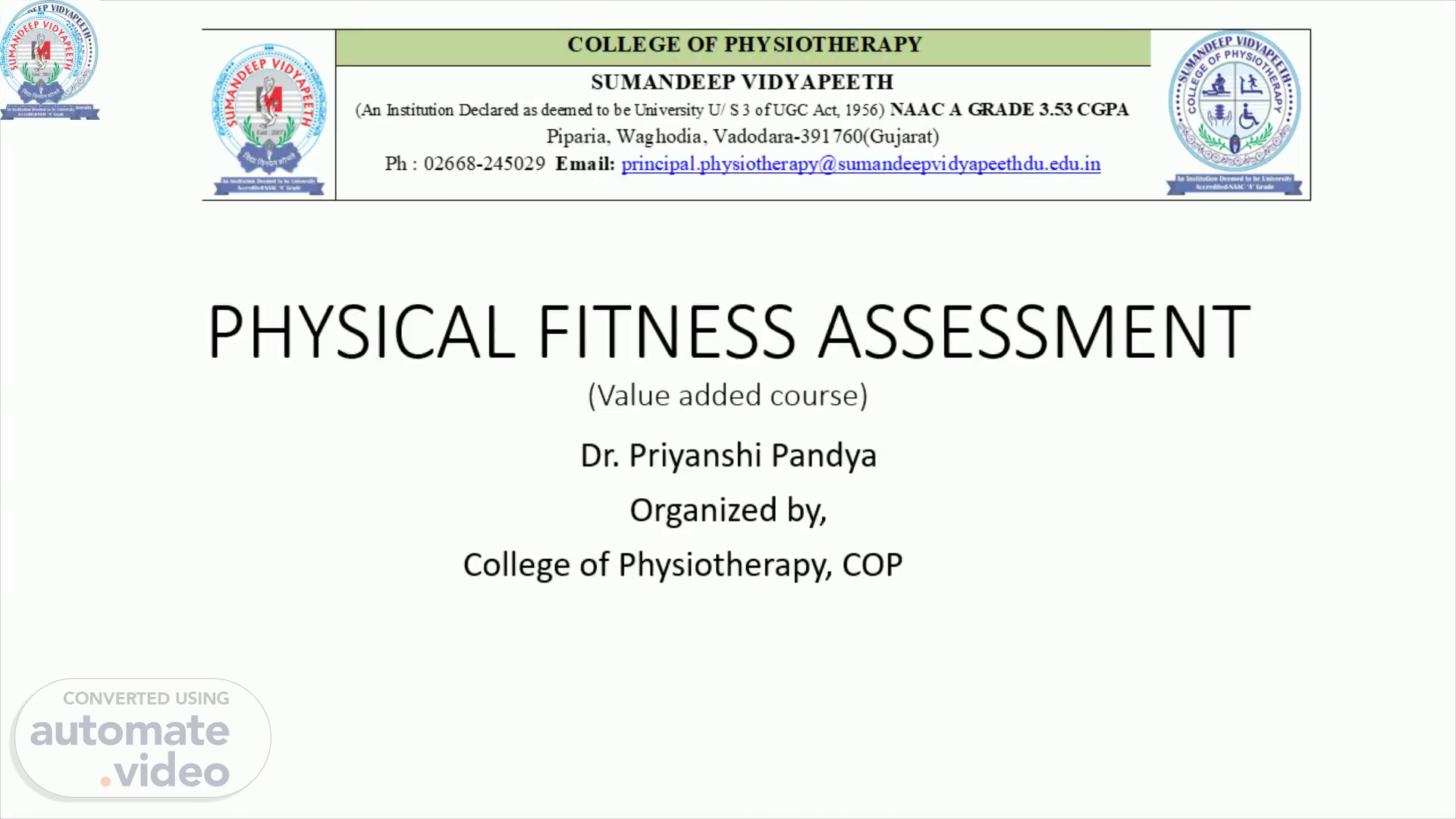
PHYSICAL FITNESS ASSESSMENT (Value added course)
Scene 1 (0s)
PHYSICAL FITNESS ASSESSMENT (Value added course).
Scene 2 (18s)
This Photo by Unknown Author is licensed under CC BY-NC.
Scene 3 (42s)
What is fitness??. Is it physical activity NO Is it exercise ?? No Is it mental stability? NO.
Scene 4 (1m 22s)
Then??? What is fitness. Fitness is a vast terminology involving Physical and Mental well being.
Scene 5 (1m 53s)
Ability to carry out daily tasks Without fatigue Ability to face emergencies Enjoy leisure time.
Scene 6 (2m 38s)
Physical fitness. The ability to carry out daily tasks with vigor and alertness , without undue fatigue , and with ample energy to enjoy leisure-time pursuits and meet unforeseen emergencies..
Scene 7 (3m 21s)
Some terminologies you may encounter during the course….
Scene 8 (5m 7s)
2. Exercise: Exercise is a type of PA consisting of planned, structured, and repetitive bodily movement done to improve and/or maintain one or more components of physical fitness.
Scene 9 (5m 58s)
Benefits of Physical fitness:. Improvement in Cardiovascular and Respiratory Function Reduction in Cardiovascular Disease Risk Factors Decreased Morbidity and Mortality Primary prevention (i.e., interventions to prevent the initial occurrence) Secondary prevention (i.e., interventions after a cardiac event to prevent another) Other Benefits.
Scene 10 (9m 0s)
Improved cardio-Respi function. Increased maximal oxygen uptake resulting from both central and peripheral adaptations Decreased minute ventilation at a given absolute submaximal intensity Decreased myocardial oxygen cost for a given absolute submaximal intensity Decreased heart rate and blood pressure at a given submaximal intensity Increased capillary density in skeletal muscle Increased exercise threshold for the accumulation of lactate in the blood Increased exercise threshold for the onset of disease signs or symptoms (e.g., angina pectoris, ischemic ST-segment depression, claudication).
Scene 11 (12m 16s)
Reduction in Cardiovascular Disease Risk Factors.
Scene 12 (14m 23s)
Decreased Morbidity and Mortality. Primary prevention Higher intensity physical activity/ fitness levels are associated with lower death rates Lower incidence rates for CAD, Diabetes type-2, CVD, stroke, many cancers, osteoporotic fractures and gall bladder diseases Secondary Prevention All cause mortality is reduced post- Myocardial Infarction (MI)/ Heart Stroke.
Scene 13 (16m 16s)
Other Benefits. Decreased anxiety and depression Improved cognitive function Enhanced physical function and independent living in older individuals Enhanced feelings of well-being Enhanced performance of work, recreational, and sport activities Reduced risk of falls and injuries from falls in older individuals Prevention or mitigation of functional limitations in older adults Effective therapy for many chronic diseases in older adults.
Scene 14 (18m 35s)
Physical fitness components. Physical fitness is composed of various elements that can be further grouped into health-related and skill-related components.
Scene 15 (19m 29s)
Health related components. Cardiorespiratory endurance: the ability of the circulatory and respiratory system to supply oxygen during sustained physical activity Body composition: the relative amounts of muscle, fat, bone, and other vital parts of the body.
Scene 16 (21m 9s)
Muscular strength: the ability of muscle to exert force Muscular endurance: the ability of muscle to continue to perform without fatigue Flexibility: the range of motion available at a joint.
Scene 17 (22m 55s)
Skill-related Physical Fitness Components. Agility Coordination.
Scene 18 (24m 14s)
Balance Power.
Scene 19 (25m 52s)
Reaction Time Speed.
Scene 20 (27m 5s)
PURPOSES OF HEALTH-RELATED PHYSICAL FITNESS TESTING.
Scene 21 (30m 16s)
Brief about various test modes in health-related Physical Fitness Assessment.
Scene 22 (31m 6s)
Thank you.